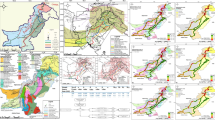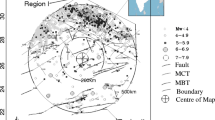Abstract
Chennai city suffered moderate tremors during the 2001 Bhuj and Pondicherry earthquakes and the 2004 Sumatra earthquake. After the Bhuj earthquake, Indian Standard IS: 1893 was revised and Chennai city was upgraded from zone II to zone III which leads to a substantial increase of the design ground motion parameters. Therefore, a comprehensive study is carried out to assess the seismic hazard of Chennai city based on a deterministic approach. The seismicity and seismotectonic details within a 100 km radius of the study area have been considered. The one-dimensional ground response analysis was carried out for 38 representative sites by the equivalent linear method using the SHAKE91 program to estimate the ground motion parameters considering the local site effects. The shear wave velocity profile was inferred from the corrected blow counts and it was verified with the Multichannel Analysis of Surface Wave (MASW) test performed for a representative site. The seismic hazard is represented in terms of characteristic site period and Spectral Acceleration Ratio (SAR) contours for the entire city. It is found that structures with low natural period undergo significant amplification mostly in the central and southern parts of Chennai city due to the presence of deep soil sites with clayey or sandy deposits and the remaining parts undergo marginal amplification.
Similar content being viewed by others
References
Ballukraya P N and Ravi R 1994 Hydrogeological environment of Madras city aquifers; J. Appl. Hydrol. 87(1–4) 75–82.
Chandra U 1977 Earthquakes of peninsular India — A seismotectonic study; Bull. Seismol. Soc. Am. 67 1387–1413.
Chang F K and Krinitzsky E L 1977 Duration, spectral content and predominant period of strong motion earthquake records from Western United States, Miscellaneous paper 5-73-1, U.S. Army Corps Engineers Waterways Experiment Station Vicksburg, Missipppi.
Gangrade B K and Arora S K 2000 Seismicity of the Indian peninsular shield from regional earthquake data; Pure Appl. Geophys. 157 1683–1705.
Ghosh A K 1994 Design basis ground motion parameters for PFBR site Kalpakkam; BARC, Mumbai.
IS 1893 (Part 1): 2002 Indian Standard Criteria for Earthquake Resistant Design of Structures: Part 1 General Provisions and Buildings (Fifth Revision).
Idriss I M 1990 Response of soft soil site during earthquakes; In: Proceedings of H. Bolton Seed Memorial Symposium (ed.) Duncan J M, University of California, Berkeley 2 273–289.
Iyengar R N and Raghukanth S T G 2004 Attenuation of strong ground motion in peninsular India; Seismol. Res. Lett. 75 530–540.
Japan Road Association (JRA) 1980 Specification and interpretation of bridge design for highway — Part V: Resilient design, 14–15.
Khattri K N 1992 Seismic hazard in Indian region; Curr. Sci. 62(1–2) 109–116.
Kijko A and Graham G 1998 Parametric-historic procedure for probabilistic seismic hazard analysis, Part I: Estimation of maximum regional magnitude M max; Pure Appl. Geophys. 152 413–442.
Kramer S L 1996 Geotechnical earthquake engineering; Prentice-Hall, Inc.
Kramer S L and Stewart J P 2004 Geotechnical aspects of seismic hazards; In: Earthquake Engineering from Engineering Seismology to Performance Based Engineering, Chapter 4.
Mark R K 1977 Application of linear statistical model of earthquake magnitude versus fault length in estimating maximum expectable earthquakes; Geology 5 464–466.
Rao B R and Rao P S 1984 Historical seismicity of Peninsular India; Bull. Seismol. Soc. Am. 74(6) 2519–2533.
Roca A, Oliveira C S, Ansal A and Figueras 2006 Local site effects and microzonation; In: Assessing and Managing Earthquake Risk (eds) Oliveria C S, Roca A and Goula X (Netherlands: Springer Publishers) Chapter 4.
Seed H B, Idriss I M and Kiefer F W 1969 Characteristics of rock motions during earthquakes; Journal of the Soil Mechanics and Foundations Divisions, ASCE 95(5) 1199–1218.
Seed H B and Idriss I M 1970 Soil moduli and damping factors for dynamic response analyses; Earthquake Engineering Research Center, University of California, Berkeley, EERC 70/10.
Seismotectonic Atlas of India 2000 Geological Survey of India, New Delhi.
Sitharam T G, Anbazhagan P and Ganesha Raj K 2006 Use of remote sensing and seismotectonic parameters for seismic hazard analysis of Bangalore; Natural Hazards Earth System Science 6 927–939.
Skempton A W 1986 Standard penetration test procedures and the effects in sands of overburden pressure, relative density, particle size, aging and overconsolidation, Geotechnique 36 425–447.
Sokolov Y V, Loh C H and Wen K L 2001 Empirical models for site- and region-dependent ground motion parameters in the Taepei area: A unified approach; Earthquake Spectra 17(2) 313–332.
Sun J I, Golesorkhi R and Seed H B 1998 Dynamic moduli and damping ratios for cohesive soils; Earthquake Engineering Research Center, University of California, Berkeley, California, EERC-88/15.
Xu Y, Xia J and Miller R D 2006 Quantitative estimation of minimum offset for multichannel surface wave survey with actively exciting source; J. Appl. Geophys. 59(2) 117–125.
Author information
Authors and Affiliations
Rights and permissions
About this article
Cite this article
Boominathan, A., Dodagoudar, G.R., Suganthi, A. et al. Seismic hazard assessment of Chennai city considering local site effects. J Earth Syst Sci 117 (Suppl 2), 853–863 (2008). https://doi.org/10.1007/s12040-008-0072-4
Received:
Revised:
Accepted:
Published:
Issue Date:
DOI: https://doi.org/10.1007/s12040-008-0072-4




